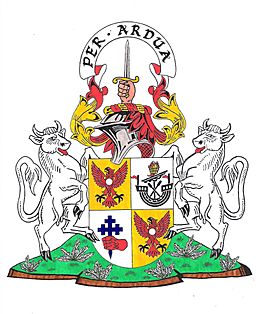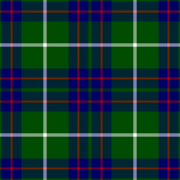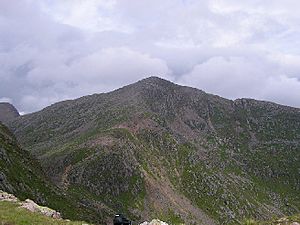Clan MacIntyre facts for kids
Quick facts for kids Clan MacIntyre |
|||
|---|---|---|---|
| Clann an t-Saoir | |||

Crest: A dexter hand holding a dagger in pale Proper
|
|||
| Motto | Per ardua (Through hardship or difficulty) | ||
| War cry | Cruachan! | ||
| Profile | |||
| District | Argyll | ||
| Plant badge | White Heather | ||
| Pipe music | We Will Take The Good Old Way | ||
| Chief | |||
 |
|||
| Donald Russell MacIntyre of Glenoe | |||
| Chief of the Name and Arms of MacIntyre | |||
| Historic seat | Glen Noe | ||
|
|||
The Clan MacIntyre (also spelled McIntyre) is a famous Highland Scottish clan. Their name, MacIntyre, comes from the Scottish Gaelic words Mac an t-Saoir, which means "son of the carpenter" or "son of the craftsman."
Most people believe the clan started with a man named Maurice Mac Neil. He was a nephew of Somerled, a very important Scottish leader from the 1100s. Maurice helped Somerled marry the daughter of the King of Mann and the Isles. This clever plan helped Somerled gain a lot more land.
Later, the clan moved from the Hebrides islands to the Scottish mainland. They made their home at Glen Noe, near Loch Etive.
The first recorded clan chiefs appeared in the 1600s. For many years, the MacIntyre chiefs held their land at Glen Noe. However, in 1806, the chief had to give up the land because he couldn't pay the rent. He and his family then moved to the United States.
MacIntyre clan members fought in big wars like the Wars of the Three Kingdoms and the Jacobite rising of 1745. They also worked as foresters for the Lords of Lorne. Plus, they were the official pipers for the chiefs of Clan Menzies and the MacDonalds of Clanranald. One of the most famous Gaelic poets, Duncan Ban MacIntyre, was also from this clan.
Contents
What Does MacIntyre Mean?
The name MacIntyre (McIntyre) means "son of a carpenter" or "son of a craftsman." Some people think it's a job-related name, like "Wright." In 1990, the official Scottish authority for names, the Lord Lyon King of Arms, recognized MacIntyre of Glenoe as the official Chief of the Name and Arms of the MacIntyre clan.
There's a lost "Black Book of Glen Noe" that was supposed to tell the clan's history. But no one has ever found it. So, the clan's beginnings are mostly based on old stories.
The Story of Somerled and the Carpenter
The most popular story connects the MacIntyres to Somerled, a powerful warrior from the 1100s. Somerled wanted to marry Ragnhilda, the daughter of King Olav the Red, the Norse King of Man and the Isles.
The story says that Somerled and King Olav were going on a raid. The night before, a ship builder named Maurice Mac Neil (who some say was Somerled's nephew) secretly drilled holes in Olav's ship. He sealed them with butter and fat.
When they sailed, the seals washed away, and Olav's ship started sinking! Somerled refused to help until Olav agreed to the marriage. Then, Maurice quickly plugged the holes with wooden stoppers he had ready. From that day on, Maurice's family was called "MacIntyres," meaning "carpenters' sons."
This marriage happened in 1140. Somerled's family later became the powerful Kings and Lords of the Isles.
How the Clan Found Glen Noe
The MacIntyres originally came from the Hebrides islands, west of Scotland. Some stories say they came from Skye, others from Islay.
The legend of how they reached the mainland and settled at Glen Noe is quite magical. They were looking for new places for their cattle. A mountain spirit blocked their way at first. After testing their courage, the spirit told them to settle where their white cow first lay down to rest. This spot became Glen Noe.
Clan History
Many stories say that around the 1200s, the MacIntyres became foresters for the Lords of Lorne. They kept this important job even as different families, like the MacDougalls, then the Stewarts, and finally the Campbells, took control of the land.
The chiefs of Glen Noe were said to have owned their land for centuries. But later, they had to pay rent to the Campbells of Breadalbane. At first, this payment was just symbolic, like a snowball in summer and a white calf.
Early Chiefs and the Civil War
The first chiefs we know about lived in the 1600s. Duncan, who died in 1695, was one of the earliest.
During the civil war in Scotland, the MacIntyre chief's home was saved by their connection to the MacDonalds. The Royalist army, led by James Graham, 1st Marquess of Montrose, was burning houses in the area. The MacIntyre chief, who supported the Campbells, fled.
But Sir Alexander MacDonald, a commander in Montrose's army, stopped his men from burning the chief's house. He did this to honor the MacIntyre ancestor, Maurice, who helped Somerled (an ancestor of the MacDonalds) marry Ragnhilda centuries before.
Many MacIntyres then joined MacDonald's army, including the chief's piper. However, the chief himself was with Campbell of Argyll at the Battle of Inverlochy in 1645, where the Campbells were defeated.
The Jacobite Rising of 1745
During the Jacobite rising of 1745, the MacIntyre chief, James, wanted to join Prince Charles Edward Stuart. But his wife, who was a Campbell, and his neighbors convinced him not to. He also felt loyal to the Campbells because the Campbell Earl of Breadalbane had helped him with his legal studies.
Even so, many MacIntyres fought in the clan regiment of Stewart of Appin during the 1745-46 campaign. They did not fight as their own separate group.
Losing Glen Noe
Over time, the symbolic payments to the Campbells changed to money rent. This rent kept going up. In 1806, the chief could no longer afford the payments. He had to give up the tenancy of Glen Noe. The chief and his family then moved to the United States.
Even though clan members always knew who the chief was, the official Scottish authorities didn't recognize the chiefship until 1991. That's when the coat of arms of James Wallace MacIntyre of Glenoe was confirmed. The current chief is Donald Russell MacIntyre of Glenoe.
Clan Tartan
| Tartan image | Notes |
|---|---|
 |
This is the MacIntyre hunting tartan. It was first shown in 1842 in a book called Vestiarium Scoticum. There's also another clan tartan with a red background and blue and green stripes. |
Famous MacIntyres: Pipers and Poets
The MacIntyres of Rannoch were the official pipers for the chiefs of Clan Menzies. They even wrote some of that clan's music. They also provided pipers for the MacDonalds of Clanranald. A famous pipe tune about the battle of Sheriffmuir was written by one of these MacIntyres.
In the 1700s, two MacIntyres became very famous for their Gaelic poetry.
James, the Poet-Chief
James (1727–1799) was a chief who also wrote poetry. He is best known for a funny poem he wrote in Gaelic. He wrote it to respond to Samuel Johnson, an English writer, who had said some not-so-nice things about the Scots.
Duncan Ban MacIntyre
Even more famous was Duncan Ban MacIntyre, born in 1724. People called him "Fair Duncan of the Songs." Some historians say he was one of the best Gaelic poets of his time, even calling him the "Burns of the Highlands." What's amazing is that he couldn't read or write!
His most famous work is "The Praise of Ben Dorain." He also wrote poems about things happening around him. During the Jacobite rising of 1745, Duncan fought for the Hanoverian side. He wrote a funny song after losing his sword at the Battle of Falkirk in 1746.
After the uprising, a law called the Act of Proscription made it illegal to wear highland dress (like kilts). Duncan wrote a very popular poem against this law and was even put in jail for a short time. When the ban on kilts was lifted, he celebrated with another poem called Orain na Briogas, or "Song of the Breeches."
Duncan was so respected that he was named the official poet for the Highland Society of London. Later in his life, schoolchildren were allowed to leave class just to see him when he visited their town. He passed away in 1812. In 1859, a monument was built near Dalmally to remember him.
Clan Profile
- Chief: Donald Russell MacIntyre of Glenoe is the official Chief of the Name and Arms of MacIntyre.
- Arms: The chief's Coat of arms has a shield divided into four parts. It shows red eagles, a ship with furled sails, and a red hand holding a blue cross. Two cows stand on either side of the shield. Above the shield is a silver helmet with a hand holding a dagger.
- Motto: Per ardua (meaning "Through hardship or difficulty").
- War Cry: "Cruachan!" This refers to Ben Cruachan, a mountain near Loch Awe.

"Cruachan" (A mountain, Ben Cruachan) is the traditional MacIntyre war cry - Pipe Music: "We Will Take The Good Old Way" (in Gaelic, Gabhaidh Sinn An Rathad Mór).
- Plant Badge: White Heather.
Images for kids


